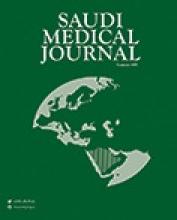Abstract
OBJECTIVE: Analysis of the clinical features, laboratory findings, treatment given and complications seen in brucellosis patients at the Northern Area Armed Forces Hospital, Hafr Al-Batin, Kingdom of Saudi Arabia.
METHODS: We retrieved and reviewed the record charts of all patients from January 1995 to December 2001 with a clinical diagnosis of brucellosis whose brucella agglutination titre was 1:160 or greater from the Medical Records Department of Northern Area Armed Forces Hospital, Hafr Al-Batin. We extracted from the files the information on age, gender, occupation, history of raw milk or milk products ingestion, presenting symptoms and physical signs. We also noted the results of routine laboratory tests, treatment given, outcome of treatment and complications.
RESULTS: One hundred and fifty-nine patients (males 101, females 58 with a ratio of 1.7:1) had a diagnostic label of brucellosis and a brucella titre of >/-1:160. Thirty-three (20.8%) were </-12, 96 (60.3%) were 13-40 years old. Twenty-six (16.4%) were 14-60 years while 4 patients (2.5%) were >/-60 years. Fever (>/-=37.7oC) featured in 126 (79.2%) patients; joint pain in 112 (70.4%); while 77 (48.4%) had bone pain. We recorded the abdominal pain in 18 patients (11.3%) vomiting in 9 (5.7%) and anorexia in 6 (3.8%); splenomegaly in 6 (3.8)%, hepatomegaly and lymphadenopathy in 2 (1.3%) patients. Brucella tube agglutination titres ranged from 1:160 to 1:5120. Thirty-eight (35.8%) patients had anemia (Hb <12 gms/dl); 12 patients (9.8%) had lymphocytosis (lymphocyte count >1 k/L). Ten patients (6.2%) had bacteremia. We used Rifampicin and doxycycline in 87 cases (54.7%), doxycycline and streptomycin in 33 (20.8%), and rifampicin and streptomycin in 20 (12.6%) for 6 weeks or longer (we used combinations including septrin in the remaining patients). We recorded relapse in 18 patients (11.3%). Pneumonia, epididymo-orchitis in 2 cases (1.3%) each, abortion, threatened abortion in one case each, complicated the disease in these patients.
CONCLUSION: Brucellosis is endemic in Northern Saudi Arabia as in other parts of the Kingdom. The clinical and laboratory features and response to therapy are also similar.
- Copyright: © Saudi Medical Journal
This is an open-access article distributed under the terms of the Creative Commons Attribution-Noncommercial-Share Alike 3.0 Unported, which permits unrestricted use, distribution, and reproduction in any medium, provided the original work is properly cited.






